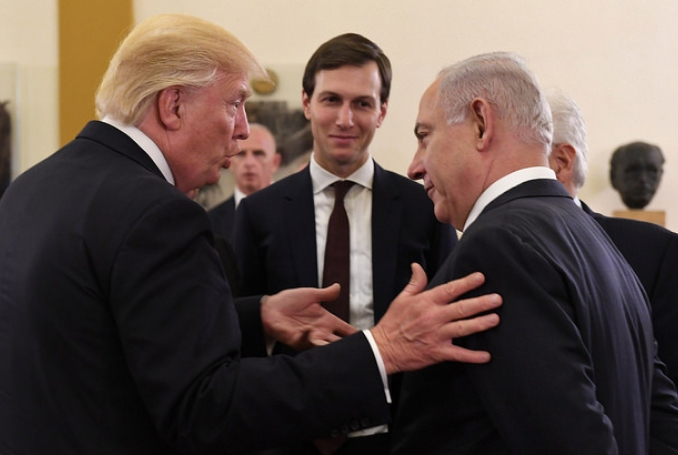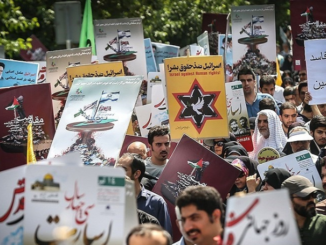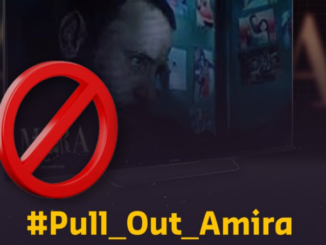
By Jeremy R. Hammond
On August 31, the US government let the world know that it would not be releasing $60 million pledged to fund the UN Relief and Works Agency (UNRWA), which is mandated to provide development and humanitarian services to Palestinian refugees, and that no further funding for the agency would be forthcoming unless it changes its definition of “refugee” to reduce their numbers by a target of 90 percent.
Days earlier, on August 24, the US had announced that it would not provide $200 million in aid that Congress had allotted this year for humanitarian and economic projects in the Israel-occupied Palestinian territories of the West Bank and Gaza Strip.
That announcement had come just days after US President Donald Trump had said that the Palestinians would “get something very good” since it was their “turn to get something” after he had shifted decades of US policy by recognizing Jerusalem as the capital of Israel and moving the State Department’s Israel embassy from Tel Aviv to Jerusalem.
The Palestinians are still waiting for their turn, it seems. While cutting funding intended to help the Palestinians survive, of course, there will be no cuts in the more than $3 billion in annual military aid that the US provides to Israel that helps sustain the oppressive occupation regime that keeps the Palestinians in need of international aid in the first place.
The purpose of the UNRWA funding cut is no secret. On August 28, US Ambassador to the UN Nikki Haley intimated that the US was going to seek reform in the UN agency specifically to ensure that the vast majority of Palestinian refugees will never be able to exercise their right to return to their homeland.
While Haley accused the UN of having a “pathetic” bias against Israel, this pretext scarcely conceals the true motive; as the New York Times observed, the UNRWA cut is “part of a plan to compel Palestinian politicians to drop demands for most of the refugees to return to what they call their homeland”—meaning to what is today Israel.
Of course, it’s not that Palestinians merely “call” this land their homeland; it is their homeland, indisputably. The Times’ language simply serves to accommodate Israel’s rejection of their right to return to their homeland, despite the same article going on to acknowledge that the refugee problem indeed exists today because Palestinians were “displaced in the 1948 war that led to the creation of the state of Israel.”
That’s the Times’ way of saying that Israel was established in 1948 by ethnically cleansing most of the Arab population from their homes in Palestine and ensuring that these refugees could never return by systematically wiping several hundred of their villages off the map.
As Israeli historian, Benny Morris put it in a 2004 interview for the Israeli newspaper Haaretz, “A Jewish state would not have come into being without the uprooting of 700,000 Palestinians. Therefore it was necessary to uproot them.”
UNRWA was established by UN General Assembly Resolution 302 (IV) of December 8, 1949, and the organization’s mandate has been repeatedly renewed (presently until June 30, 2020), because of the world’s failure to obtain a just solution to the Palestinian refugee problem.
The just solution is outlined in UN General Assembly Resolution 194 (III) of December 11, 1948, which resolved,
“that the refugees wishing to return to their homes and live at peace with their neighbors should be permitted to do so at the earliest practicable date, and that compensation should be paid for the property of those choosing not to return and for loss of or damage to property which, under principles of international law or in equity, should be made good by the Governments or authorities responsible . . . .”
Of course, the reason this solution has not been implemented is because Israel continues to refuse to permit these rightful inhabitants to return to their homeland as it would mean the end of Israel’s existence as a “Jewish state”.
This demographic threat is why the Israeli legislature last month passed its Jewish Nation-State Law, which explicitly declares that the right to self-determination in Israel is “unique to the Jewish people.” Far from being founded on democratic principles or through any kind of legitimate political process (the popular notion that the UN created Israel is a myth), Israel’s founding through war and ethnic cleansing was the ultimate manifestation of the rejection by the Zionists and their Western benefactors of the Arab Palestinians’ right to self-determination.
As a consequence of Israel’s refusal to permit Palestinian refugees to return to the land from which they were forcibly expelled, their numbers have swelled so that today about five million Palestinians are registered as refugees with UNRWA.
As the aforementioned Times article further noted,
“The vast majority of the five million refugees are descendants of Palestinians displaced in the mid-20th century. The United Nations aid agency officially considers all of them refugees, consistent with international law and United Nations refugee protocols, said Peter Mulrean, director of the Unrwa office at the United Nations.”
The Trump administration wants UNRWA to deny refugee status to the descendants of those who lived through the ethnic cleansing, which would render it practically impossible for them to ever exercise their internationally recognized right to return to their familial homeland.
The US has been the biggest funder of UNRWA and on average has provided more than $350 annually to the agency since 2010. But in January, the Trump administration announced that it was withholding $65 million from a $125 million payment to UNRWA, the first of a number of payments pledged to the agency for the year. The total amount the US pledged to fund UNRWA this year was $350 million, of which that initial $60 payment was the only amount delivered.
While UN-run schools in the West Bank and Gaza opened on time and some countries have responded by increasing aid to UNRWA—including Qatar and the United Arab Emirates, who each pledged an additional $50 million, and Germany, which has so far this year provided about $95 million and pledged a “substantial” increase—the agency is still suffering a shortfall and has had to lay off dozens of teachers, as well as 100 workers in refugee camps in Jordan. Agency officials have expressed their fear that UNRWA will be too short funded to continue running its schools, lacking the funds to pay 22,000 teachers in schools located not only in Gaza and the West Bank, but also in refugee camps in Jordan, Syria, and Lebanon.
The initial withholding of UNRWA aid in January came just one month after Trump expressed his view that Jerusalem is the capital of Israel and declared that the US would, therefore, move its Israel embassy from Tel Aviv to Jerusalem.
Not communicated to the public in media reporting about the embassy move, either then or since, is the fact that this move violates the UN Charter (and hence also the US Constitution). It is, in other words, illegal, a violation of UN Security Council Resolution 478 of August 20, 1980, which forbade UN member states from locating their embassies in Jerusalem due to the fact that Israel had implemented illegal measures to annex the city.
While the media habitually refer to East Jerusalem, as well as land where Israel has illegally constructed Jewish settlements, as “disputed” territory, the reality is that it is a completely uncontroversial point of fact under international law that all of Gaza and the West Bank, including East Jerusalem, are “occupied Palestinian territory”.
Resolution 478 is just one of seventeen UN Security Council Resolutions that have been passed since the June 1967 war condemning Israel for its measures to annex Jerusalem, which under international law are illegal, null and void.
It was during that war, which began with an Israeli surprise attack on Egypt, that Israel invaded and occupied the West Bank and Gaza. While Israeli military forces were withdrawn from Gaza in 2005, Israel remains legally the Occupying Power there due to its effective control over the territory, including control over Gaza’s territorial waters, airspace, and “borders” (neither Gaza nor the West Bank have legally defined borders with Israel; there are only the 1949 armistice lines, which also means Israel technically doesn’t meet the criteria for statehood under the Montevideo Convention on the Rights and Duties of States).
In 2006, Hamas won legislative elections, which Israel and the US responded to by conspiring with rival party Fatah and the President of the Palestinian Authority (PA), Mahmoud Abbas, to overthrow the legitimate Hamas government. That plan was only partially successful. While Abbas still remains in power nearly a decade after his legal term expired, the coup failed in Gaza, where Hamas still remains in power.
Israel responded to the failed coup by escalating its existing blockade of Gaza into a full-scale siege in order to collectively punish the entire civilian population for having Hamas as governing authority. In the words of the US State Department in a November 2008 cable from the US embassy to Secretary of State Condoleezza Rice, the purpose of Israel’s blockade was “to keep the Gazan economy on the brink of collapse.”
On July 19, members of the team appointed by Trump to revive the stalled “peace process” and negotiate what he once said would be the “deal of the century” published an op-ed in the Washington Post effectively declaring the Trump administration’s support for Israel’s illegal blockade policy.
As though to rub salt in the wound for the Palestinians, the date chosen for the official opening of the new US embassy in Jerusalem was May 14, the 70th anniversary of the Zionist leadership’s unilateral declaration of the existence of the state of Israel in 1948.
While the New York Times typically explains the refugee problem as being the unfortunate consequence of a war started by the neighboring Arab states, the truth is that by the time the Arab states sent their armies into Palestine, 300,000 Arabs had already been ethnically cleansed from their homes by the Zionist forces, a number that would increase to more than 700,000 by the war’s end.
On May 15, Palestinians commemorate al-Nakba, or “the Catastrophe”, a reference to their mass expulsion from their homeland in order for the “Jewish state” to come into being.
This, then, is the nature of Trump’s “deal of the century”: throwing the weight of the US behind Israel’s illegal annexation of Jerusalem, supporting Israel’s policy of collectively punishing the civilian population of Gaza, and working to ensure that a just solution to the Palestinian refugee problem can never be obtained, all the while continuing to finance Israel’s occupation and settlement regime.
While the details of the Trump administration’s supposed “peace” plan have not yet been forthcoming, it is clear that the idea is to coerce the Palestinians into agreeing to comply with Israel’s demands to surrender their internationally recognized rights. In short, Trump’s plan is to use the power he wields to help Israel ensure that the Palestinians cannot exercise their right to self-determination.
Instructively, while cutting $200 million in aid for humanitarian and economic projects in the West Bank and Gaza, the Trump administration made sure that the PA got its money. On August 2, the amount of $61 million was released for funding security cooperation between the PA and Israel.
This is because of the role the PA was created to fulfill under the Oslo “peace process”, which is to serve as Israeli collaborator in enforcing its occupation regime. If the PA were to collapse, the Israel Defense Forces (IDF) would have to take over responsibility for ensuring the Palestinians are kept in line, which would be a far costlier and more politically unsustainable endeavor (which is why the PA was envisioned for this role in the first place).
While Abbas’s illegitimate regime got its funding, among the reasons cited for the $200 million cut in aid for humanitarian and economic projects were Hamas’s control of Gaza and, in the words of Nikki Haley, “most importantly” because “the Palestinians continue to bash America.”
Naturally, the Palestinians criticize the US government’s role as the party most responsible for enabling Israel’s oppression against them.
Nor is this some new role that the US has taken up only under the Trump administration.
In an editorial criticizing the Trump administration for believing he can compel the Palestinians into compliance with the US and Israel’s demands by slashing aid and attempting to strip them of their refugee status, the New York Times maintained that Trump has “effectively abandoned the critical role his predecessors have tried to fulfill as peace brokers”. Past administrations, the Times claimed, had “sought to resolve” the conflict “through diplomacy.”
In fact, as I document in my book Obstacle to Peace: The US Role in the Israeli-Palestinian Conflict, the goal of the US-led so-called “peace process” has always been to block implementation of the two-state solution, which is premised on the applicability of international law to resolving the conflict.
Before Trump declared his view that Jerusalem was Israel’s capital, Barack Obama had done so. As a Senator campaigning for the presidency, on July 23, 2008, Obama gave a speech in Sderot, Israel, professing his commitment to backing Israel and intimating that if he succeeded in becoming president, “Jerusalem will be the capital of Israel”. Unlike Trump, Obama just didn’t follow through on this campaign promise, although he had good reasons not to, which he was evidently educated about after winning the presidential election.
The Obama administration did, however, provide unprecedented support for Israel’s crimes against the Palestinians, which included opposing the Palestinians’ diplomatic efforts at the UN to resolve issues through the application of international law.
The whole “peace process” is premised on a fundamental rejection of the applicability of international law. Instead, the idea has always been to compel the Palestinians through violence and other means of coercion into accepting Israel’s demands that they surrender their rights.
Trump’s “deal of the century” is just more of the same. The only real difference between his policy and those of his predecessors is that he is trying to revive the “peace process” while failing to recognize the need for the US to maintain some semblance of credibility as a supposedly neutral mediator in the eyes of the world’s governments. (This is the thing Obama was evidently educated about after making it to the Oval Office, but which Trump seems to be incapable of comprehending.)
In this sense, Trump’s prejudicial treatment of the Palestinians and support for Israel’s crimes against them are a positive development; by totally eliminating the US government’s credibility as a supposed peacemaker, it opens up the path politically for the Palestinian leadership to move forward with diplomatic efforts, opposed by the US, to seek legal remedy for Israel’s violations of international law and their human rights through institutions like the International Court of Justice (ICJ) and International Criminal Court (ICC).
Of course, the main obstacle there is the lack of solidarity between the Palestinian leadership in Gaza and the leadership in the West Bank. A round of Egyptian-mediated reconciliation efforts in July failed because Abbas demanded that Hamas completely surrender Gaza to his control. Abbas has furthermore joined in Israel in taking actions to collectively punish the civilian population of Gaza, including sanctions on Gaza’s banking system, salary cuts for government employees, and from April 2017 to January 2018 effectively cutting off Gaza’s the electricity supply.
Abbas has also opposed Egyptian-mediated efforts to reach a ceasefire agreement between Hamas and Israel, who have been exchanging blows with each other on and off since March, when Gazans began having weekly demonstrations along the armistice line fence to protest Israel’s rejection of refugees’ right to return and Israel responded with unlawful use of force against unarmed demonstrators.
In mid-August, Abbas criticized the ceasefire efforts, demanding that the PA be involved and control any aid that reaches Gaza. The head of Hamas political bureau and former prime minister, Ismail Haniyeh, responded by saying that Hamas was “on the way to ending the blockade on Gaza” and that “humanitarian aid to Gaza will not be made at a diplomatic price”.
He also described Trump’s “deal of the century” as “clinically dead”.
While Hamas in October 2017 signed an Egyptian-brokered reconciliation agreement with Fatah to hand over administrative control of Gaza to the PA, Haniyeh also insisted that Hamas would continue to be responsible for maintaining security and that the PA must lift its sanctions on Gaza for reconciliation talks to resume.
Near the end of August, Abbas reportedly proclaimed that a ceasefire agreement would be reached between Hamas and Israel “over my dead body”—which may not be long in coming given reports of his deteriorating health.
According to senior Fatah member Hissein al-Sheikh, Abbas also said, “If the agreement is signed without the PA’s permission, it is illegal and constitutes treason”—strong words for a politician who remains in office nine years after the expiration of his legal term and eleven years after conspiring with Israel and the US to illegally overthrow the democratically elected Hamas government.
What can explain Abbas’s behavior? As Israeli journalist Shlomi Eldar has observed in Al-Monitor, “Abbas is not so naïve that he believes that Hamas would give overall security authority over to him at once, and even Israel and Egypt agree that it must happen gradually.” Hence, he must have other reasons.
As a consequence of his failing health,
“senior members of the Fatah movement are readying for a battle over succession, and anyone who sees himself as a contender for his office is preparing for a violent struggle and recruiting armed forces who would stand on his side if needed.”
Their calculation is that
“the entry of Palestinian Authority forces to the Gaza Strip in the framework of reconciliation with Hamas could harm their chances of being chosen to replace Abbas. Entering Gaza would change the rules of the game, and each candidate prefers to keep the status quo they know so well.”
Hence Abbas’s close advisors “are influencing him not to agree to reconciliation”. The fear is that if Hamas succeeds in achieving a ceasefire agreement that results in an easing of the blockade of Gaza, it would be a political victory for Hamas made at the expense of Fatah and the PA.
According to a reconciliation agreement reached in April 2014, there were supposed to have been presidential and parliamentary elections by that October, which never happened. The agreement reached in October 2017 also stipulated that general elections will be held by the end of 2018. But that seems unlikely to happen, given Fatah’s fear of losing to Hamas.
As Eldar notes, Fatah members scrambling to place themselves in a position to succeed Abbas fear that the election of a new party leader also
“will likely lead to general Palestinian elections, and none of those who see themselves as candidates are prepared at this stage to change the rules of the game for fear that Hamas would win in these elections, if and when there’s an agreement to hold them.”
The Trump administration, for its part, has said it strongly supports Egypt’s efforts to mediate a ceasefire agreement, with the caveat that such an agreement must “bring about the conditions for the Palestinian Authority to fully assume its responsibilities in Gaza”. Pressure from the US thus also helps to explain Abbas’s opposition to an agreement that would bring much-needed relief to the civilian population of Gaza.
However, the Trump administration’s actions will likely serve only to strengthen Hamas. As PLO Executive Committee member Hanan Ashrawi told the New York Times with respect to the UNRWA funding cut,
“If you deprive people of their education, their health—their future—this is extremely serious and dangerous … Who is going to step in? If you want to hand them over to the religious schools, to Hamas, then you have to live with the consequences.”
In November 2012, the UN General Assembly recognized Palestine as a state, which opened the pathway to the Palestinian leadership seeking remedy for Israel’s violations of international law through the international legal mechanisms of the ICJ and ICC. By eliminating the last semblances of credibility of the US-led “peace process” and its sham so-called “negotiations”, the Trump administration has actually created an opportunity for the Palestinians to pursue this course of action in order to bring about an end to Israel’s occupation and settlement regime.
Whether a unified Palestinian leadership will emerge with the will and courage to do so is another question. Trump’s “deal of the century” could unintendedly help bring about an end to the status quo of occupation. But it seems that a prerequisite for this to occur is the dissolution of Israel’s collaboration regime ruling the West Bank and the establishment of a legitimate Palestinian government. And while such a government would have the support of most of the world, their present leadership is an obstacle the Palestinians alone must overcome.
(This article was originally published at Foreign Policy Journal.)
– Jeremy R. Hammond is an independent political analyst, publisher and editor of Foreign Policy Journal, and author. His new book is Obstacle to Peace: The US Role in the Israeli-Palestinian Conflict. His website is JeremyRHammond.com. He contributed this article to the Palestine Chronicle.







